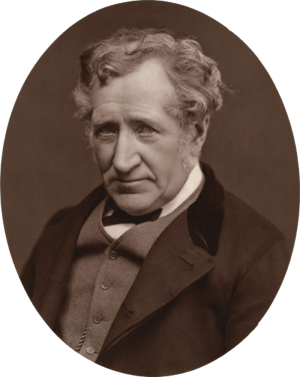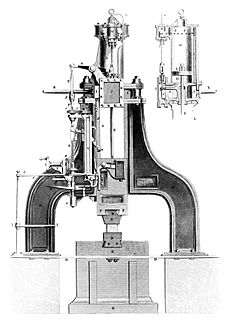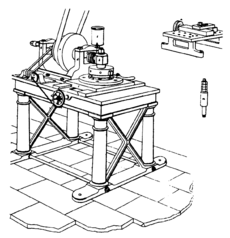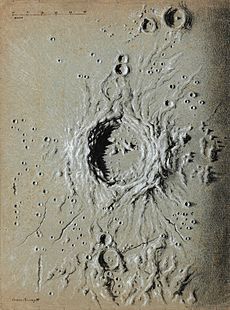James Nasmyth facts for kids
Quick facts for kids
James Nasmyth
|
|
|---|---|

Woodburytype print, c.1877
|
|
| Born | 19 August 1807 Edinburgh, Scotland
|
| Died | 7 May 1890 (aged 81) |
| Nationality | Scottish |
| Citizenship | British |
| Alma mater | Heriot-Watt University |
| Known for | Steam hammer Machine tools Locomotives Astronomy Photography |
| Scientific career | |
| Fields | Mechanical engineer Artist Inventor |
| Institutions | Nasmyth, Gaskell and Company,(1836–50) James Nasmyth and Company (1850–56) |
James Hall Nasmyth (born August 19, 1808 – died May 7, 1890) was a clever Scottish engineer, artist, and inventor. He is best known for inventing the steam hammer, a powerful machine used to shape metal. He also helped start a company called Nasmyth, Gaskell and Company, which made machine tools. After retiring at 48, he enjoyed his hobbies of astronomy (studying stars) and photography.
Contents
Early Life and Mechanical Skills
James Nasmyth was born in Edinburgh, Scotland. His father, Alexander Nasmyth, was a famous painter. Alexander also loved mechanics and spent much time in his workshop. He encouraged James to work with him, teaching him how to use different materials.
James went to the Royal High School. There, he became friends with Jimmy Patterson, whose father owned an iron foundry. James spent a lot of time at the foundry, learning how to work with wood, brass, iron, and steel. When he was 17, he built his first steam engine in his father's workshop.
From 1821 to 1826, James attended the Edinburgh School of Arts, which is now Heriot-Watt University. In 1828, he built a complete steam carriage. This carriage could carry eight passengers for a mile! This achievement made him want to become a mechanical engineer even more.
He wanted to work for Henry Maudslay, a famous engineer. Since he couldn't afford to be an apprentice, James built a working model of a steam engine. He drew all the plans and built every part himself.
Starting a Career in Engineering
In May 1829, James Nasmyth visited Maudslay in London. Maudslay was very impressed with James's work. He hired James as an assistant for 10 shillings a week. Sadly, Maudslay died two years later. James then worked as a draughtsman for Maudslay's business partner.
When James was 23, he had saved £69. He decided to start his own business. He rented a factory space in an old cotton mill in Manchester.
The factory had a wooden floor, which was not ideal for heavy machinery. After an accident where an engine part crashed through the floor, he moved. In August 1836, he and his partner Holbrook Gaskell opened the Bridgewater Foundry in Patricroft, near Manchester. Their company was called Nasmyth, Gaskell and Company. The new factory was built next to the Liverpool and Manchester Railway and the Bridgewater Canal.
In 1840, James started getting orders for locomotives from the new railways. He also received a special request from the Great Western Railway. They needed very large and powerful machine tools. These tools were for building the engines of their new ship, the SS Great Britain.
Inventing the Steam Hammer
In 1837, the Great Western Steam Company faced a big problem. They needed to forge a huge shaft for their ship, the SS Great Britain. Their largest hammer wasn't powerful enough. In 1838, the company's engineer asked Nasmyth for help.
James thought about the problem. He saw that old "tilt-hammers" hit with the same force every time. He sketched his idea for a new machine: the first steam hammer. He kept his ideas in a "Scheme Book" and often showed them to customers. He drew his steam hammer design on November 24, 1839. However, the immediate need for the hammer disappeared. The Great Britain was changed to use screw propellers instead of paddle wheels.
Around the same time, a French engineer named François Bourdon had a similar idea. He called his machine a "Pilon." Bourdon made detailed drawings and showed them to engineers who visited the Le Creusot works in France.
Bourdon and Eugène Schneider visited Nasmyth's factory in England in 1840. Nasmyth showed them his sketch of the steam hammer. This helped Schneider believe the idea was possible. In 1840, Bourdon built the world's first steam hammer at the Schneider & Cie works. It weighed 2,500 kilograms (5,500 lb) and could lift to 2 metres (6 ft 7 in). The Schneiders patented the design in 1841.
In April 1842, Nasmyth visited France. He went to the Le Creusot works and saw the steam hammer working. He said it was "a thumping child of my brain!" Nasmyth patented his own design in June 1842. He built his first steam hammer later that year at his Patricroft factory. In 1843, a disagreement started between the two engineers about who invented it first.
The steam hammer greatly reduced production costs, sometimes by more than 50 percent. It also made the metal parts much better quality. Early hammers were "free-fall" types, but later ones had power-assisted fall. Before Nasmyth's invention, large metal parts like ship anchors had to be made piece by piece.
A key feature of Nasmyth's hammer was that the operator could control the force of each blow. He loved to show how it could gently crack an egg in a wine glass without breaking the glass. Then, with a full-force blow, it would shake the whole building! Soon, Nasmyth hammers were used in large workshops everywhere.
An original Nasmyth hammer stands outside his old Patricroft factory. A larger Nasmyth & Wilson steam hammer is at the University of Bolton.
Nasmyth also used his steam hammer idea for a pile-driving machine. He invented this in 1843. His first machine used a four-ton hammer-block and could hit 80 blows per minute. It was first shown in a competition on July 3, 1845. It drove a 70-foot-long pile into the ground in just four and a half minutes. The old method took twelve hours! This was a huge success, and many orders came in. His pile driver was used for big projects worldwide, like the High Level Bridge in Newcastle upon Tyne and the Nile barrage in Egypt.
By 1856, 490 hammers had been made and sold across Europe, Russia, India, and Australia. They made up 40% of his company's income.
Other Important Inventions
Besides the steam hammer, Nasmyth created other important machine tools. These include the shaper, which is still used today. Another invention was a hydraulic press. This machine used water pressure to push tightly fitting machine parts together. These machines became very popular in factories and are still used in modified forms.
Nasmyth was also one of the first to offer standard sizes of machine tools. Before him, tools were custom-made for each client. This caused problems with parts fitting together. Nasmyth helped make manufacturing more organized.
Many of Nasmyth's other inventions were never patented. These included a flexible shaft made of coiled wire for moving things, a machine for cutting key grooves, and self-adjusting bearings. He also invented the screw ladle for moving hot metal. This ladle allowed two men to do a job that used to need six!
He also worked on a way to convert iron, similar to what Henry Bessemer later patented. Nasmyth decided not to patent his own method after hearing about Bessemer's ideas in 1856. However, Bessemer recognized Nasmyth's work. He offered Nasmyth a one-third share of his patent for the famous Bessemer process. Nasmyth turned it down because he had decided to retire.
Later Life and Hobbies
James Nasmyth retired from business in 1856, when he was 48 years old. He said he had "enough of this world's goods" and wanted to give younger men a chance. He moved to Penshurst, Kent, and named his home "Hammerfield." There, he happily pursued his many hobbies, especially astronomy.
He built his own 20-inch reflecting telescope. While doing so, he invented the Nasmyth focus, a special way to view objects through a telescope. He made detailed observations of the Moon. He even co-wrote a book called The Moon: Considered as a Planet, a World, and a Satellite (1874) with James Carpenter.
In this book, they included interesting "lunar" photographs. Back then, cameras couldn't take clear pictures of the Moon at high magnification. So, Nasmyth built plaster models of the Moon's surface based on his observations. Then, he photographed these models under electric light to show the shadows and shapes of the Moon's features. A crater on the Moon is named after him.
James was happily married to his wife, Anne, for 50 years. They did not have any children. They are buried in the Dean Cemetery in Edinburgh. Their large memorial has a model of his steam hammer.
Recognition
To honor his great contributions to mechanical engineering, the Mechanical Engineering building at Heriot-Watt University in Edinburgh is named the James Nasmyth Building.
See also
 In Spanish: James Nasmyth para niños
In Spanish: James Nasmyth para niños






